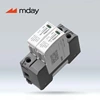What Are The Consequences Of Not Installing A Surge Protector?
1. Project acceptance is unqualified
For projects such as new buildings, if the qualified standards for lightning protection acceptance are not met, the project may not pass the acceptance, which will in turn affect its sales. For example, the main distribution cabinet of the building must be installed with a first-level surge protector that meets the corresponding requirements. If the installation of the surge protector is lacking or does not meet the standards, the lightning protection acceptance will fail.
2. The equipment lacks lightning protection
The function of the surge protector is to discharge the surge current on the line and limit the overvoltage. If the surge protector is not installed, the surge current and overvoltage on the line will be directly applied to the equipment, causing damage to the equipment and even fire accidents. Considering the possible serious economic losses, we might as well install appropriate surge protection devices in front of the equipment with surge risks. This can effectively avoid potential dangers and reduce the cost of repairing and replacing equipment.
Therefore, installing a surge protector is not only in line with the requirements of standards and specifications, but also a necessary measure to ensure the safe and reliable operation of equipment. In actual projects, strictly complying with relevant standards and specifications and reasonably selecting and installing surge protectors will help reduce the risk of equipment damage and improve the stability and reliability of the power system.











